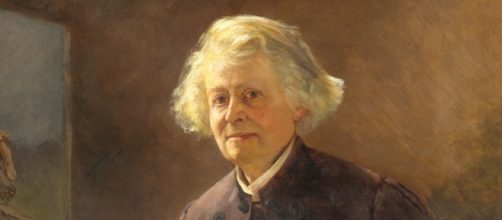Her parents were artists who urged her to “blaze her own trail.” Rosa Bonheur got the message. Instead of painting traditional subjects like portraits, landscapes and still life, she chose to picture wild animals.
She’s probably best known for depicting oxen pulling a plow (“Plowing the Nivernais.”) The Literary Digest of 1890 believed this scene was influenced by the opening scene in George Sand’s 1846 novel “La Mare au Diable” (The Devi’s Pool), about country life.
“Plowing the Nivernais,” which shows man and nature working together, won France’s coveted gold medal of Salon in 1849.
But praise from French art critic Théophile Thoré-Bürger came off as backhanded: “Mademoiselle Rosa paints almost like a man."
Sexism in the art world
Praise like that is like saying that women are lousy artists and only if they paint like men can they be any good. But such thinking was commonplace in the 19th century.
Consider the case of American sculptor Anna Hyatt Huntington’s life-size bronze of Joan of Arc astride a horse. It won first place at the 1910 exhibit in Paris. But, when the judges found out a woman had done the work, they took back the award, saying that it was too good to have been sculpted by a woman.
Bonheur kept on winning awards. “The Horse Fair” – a giant eight feet by sixteen feet canvas – won the Camee brochure from the City of Ghent in Belgium in 1854, awarded by the Société royale des beaux-arts et de littérature de Gand.
It’s notable that women weren’t allowed to attend public events like this. But Bonheur dressed like a man to get around town. She was the first female to win a cross of the Legion of Honor. Napoleon’s wife, Empress Eugénie, personally conferred the award, saying: “Genius has no sex.”
What took so long?
To honor Bonheur’s birth two centuries ago, the Musee d’Orsay has mounted a retrospective of some 200 works, contending it’s the largest show of her work ever mounted.
The Musee d’Orsay gets no bragging rights for giving Bonheur her due. Her accomplishments are no small thing. She captured animals in motion so vividly that you imagine you can hear them moving. And to achieve accuracy in rendering their anatomy, Bonheur visit slaughterhouses.
Given that she made the visits in trousers, she was required to get a license from the police department. The police made her renew it every six months.
Being mocked for sketching in slaughterhouses, Bonheur felt compelled to say: "My brusque and even slightly unsociable nature has never prevented my heart from remaining completely feminine.''
Why did it take so long for a museum in Bonheur’s native land to honor her with this exhibit? Can it be because she not only “blazed her own trail” in her art, but also in her personal life.
She not only wore men’s clothes, but she also smoked, hunted, and lived with women, famously saying: “The fact is, in the way of males, I only like the bulls I paint.” Can the French art world have been prissy all this time?


